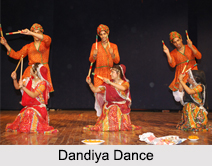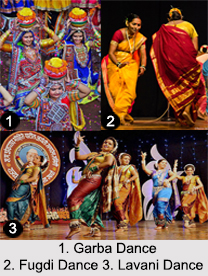 Folk dances in Western India are plenty in numbers. Strongly related to the original rituals and cultures, some of the folk dances are still common in many parts of the country, while others have washed away with the rebuilding process of the art. The Western Indian Folk dances are multi-coloured and energetic in nature.
Folk dances in Western India are plenty in numbers. Strongly related to the original rituals and cultures, some of the folk dances are still common in many parts of the country, while others have washed away with the rebuilding process of the art. The Western Indian Folk dances are multi-coloured and energetic in nature.
Different Folk Dances in Western India
Following are different Folk Dances in Western India:
Dandiya Dance: "Dandiya" dance is the folk dance of Gujarat, which demonstrates the great heartiness and joy of the inhabitants of the Western States of India. The dancers are accompanied by the musical instrument called the `Meddale`, which is played by the drummer placed in the centre.
Dulpod Dance: "Dulpod" dance is a form of dance in Western India. The main themes of this dance are derived from quick rhythm and everyday life of the "Goans". The tunes are based on the "dulpod" which are generally in six-eight in measure. The "dulpod" is usually performed in a sequence with a "Mando".
Garba Dance: "Garba" Dance is so well-liked that there are a lot of modern versions of it. Most of the "Garba" songs are in honour of the Goddess but the other subjects have come into use, like the stories of Krishna. The "Garba" Dance is massively popular in Gujarat.
Dindi and Kala Dance: "Dindi" and "Kala" Dances are devotional dances of Maharashtra. In these dances, Lord Krishna is presented. "Dindi" is a small drum. The musicians, comprising `Mridangam` player and a vocalist, stand in the centre and give the dancers necessary musical background.
 Koli Dance: Koli Dance is a well-liked dance form of the fishermen community of "Kolis" residing in the coastal areas of Maharashtra. This active dance helps people of this community to relax after a hard day"s work and forget several hardships that their profession presents to them on an every day basis.
Koli Dance: Koli Dance is a well-liked dance form of the fishermen community of "Kolis" residing in the coastal areas of Maharashtra. This active dance helps people of this community to relax after a hard day"s work and forget several hardships that their profession presents to them on an every day basis.
Fugdi Dance: It is a "Goan" folkdance performed by the women in the "Konkan" region, and thus another dance form of western India. These dances are performed in many Hindu religious festivals like Ganesh Chaturthi, "Dhalo" and in other social and religious occasions. "Fugdi" is an art form that can be traced to the primeval cultural traditions of Goa.
Dhalo Dance: It is one of the most popular rural dances of Goa and western India. "Dhalo" is performed by women folk on the moonlit night of Hindu `Pausha` month. The dance is performed by "Kunbis", "Bhandari", "Naik", "Gabit" and "Gaudi" communities. According to the legends, Radha used to sing love songs which are known as "dhalos" to Lord Krishna. Earlier "dhalos" referred only to the love of Krishna and Radha. Gradually people developed the songs which were sung in praises to other Gods also.
Tippani Dance: It is another folk dance of Western India. The dance starts slowly, with the singing and beating of the ground done in the same rhythm. As the speed go faster, the dancers alternately pound the floor and strike the handles of the hammers together, and then set up body movements, generally bending and raising themselves.
Goaf Dance: This dance is a copied of the "Dandiya Raas". The dancer"s movements are choreographed in a way so that the ropes are woven and unwoven to make various patterns. The dancers also strike the sticks as they dance.
Lezim Dance: "Lezim" is performed all through the "Ganesh Chaturthi" festival. The "lezim" is made of a wooden stick. The movements of "Lezim" look like calisthenics and martial in origin. Different formations are created during the dance.
Kunbi Dance: This dance belongs to the "Kunbi" Tribes who were the earliest settlers of Goa who are a sturdy tribal community. The group was mostly settled in "Salcete taluka". "Kunbi" dance is performed solely on social occasions. It is performed by the women folk. The movements are fast yet graceful. The attires of the performers are colourful but simple, conforming to the tribal tradition. Their songs and dance belonging to the pre-Portuguese era are uniquely social and not religious.
Lavani Dance: The dance is presented by women only, and has positive typical playful movements, like holding the "pallu" of the "saree" behind their heads and sliding it back and forth, and gyrating of the hips. "Lavani" is performed for male audiences.
Lamp dance: It is one of the famous dances of Goa. This dance derives its name from brass lamps used in the dance during the Shigmo festival in the month of March. Different types of instruments are associated with the dance which includes "Ghumat", "Samael", "Cymbal" and "Harmonium". The performers indulge in a slow dancing movement, balancing brass lamps with burning wicks on the head and the hands. The balancing act demands tremendous control and self-discipline. The performers need to be highly skilled and expert in their performance.
Supdu Dance: It is one of many Gujarati dances celebrating every day working life in villages. This professional dance takes its name from a grain cleaning basket, or "supdu".
The tribal of Dadra and Nagar Haveli have their dance form of "Tarpa" and the manifestation becomes even more enticing during moonlit nights and continues past midnight and is indeed the specific dance of the region.



















